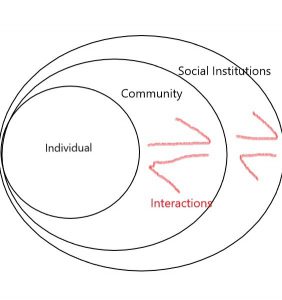Jeremy Laporte
For several months, I have been considering the place of trauma in community psychology. These thoughts were sensible, considering the events occurring in my life over that time. I recently left a job in the mental health field where I often had knowledge of my clients’ trauma experiences and witnessed the effects firsthand. This experience piqued my interest in psychological trauma. I hoped to investigate the topic further as I started graduate school for community psychology. As I became more familiar with both concepts, however, I began to doubt whether this was possible. Trauma tends to be defined in terms of the individual, while community psychology, by definition, looks at larger contexts. Fortunately, a section on child maltreatment in an article (Prilleltensky, 2001) changed my thinking. The section detailed how this problem, which is undoubtedly enacted on an individual level, can be tied to larger social forces. As such, I intend to use this post to explore the relationship between trauma and community psychology’s values of personal, relational, and collective well-being.
The Substance Abuse and Mental Health Services Administration (SAMHSA) includes a negative effect on individual well-being in the definition for trauma found on their website. (“Trauma and Violence”, 2017) This website also shows a potential role for relational well-being when discussing trauma. It indicates that the negative behavioral and mental health effects of trauma can impact an individual’s relationships, namely with their family members. Further, it points to the importance of social support in mitigating these negative effects. Strong, supportive relationships can empower a person to continue with their lives after a traumatic experience with little impact to their functioning. Thus, healthy relational well-being is an important factor in trauma’s impact on individual well-being. This also provides a possible area of intervention for community psychology. The field provides techniques for increasing and strengthening social connections. If individuals in a particular community are likely to experience traumatic events, these interventions may lessen the effects of these experiences.
Tying trauma to collective well-being is more difficult. While the behavioral changes (substance abuse, aggression, etc.) that may result from traumatic experiences will likely have a negative impact on the community, this is still the outcome of trauma’s effects on individual well-being. However, unhealthy collective well-being can produce trauma, as conditions such as community violence are tied to traumatic experiences. Further, certain types of trauma, such as domestic violence and child neglect, can be tied to social conditions like poverty. Therefore, community psychology’s pursuit of social justice plays a role in decreasing traumatic experiences in disempowered populations. This framework is still overly focused on trauma as impacting individual well-being, though.
Fortunately, as detailed by Prilleltensky (2001), this is not an uncommon problem for community psychology, as the field generally struggles to direct equal attention to collective well-being. It does not necessarily remove trauma from the scope of community psychology, but opens the possibility for the field to expand on the concept using its unique values and vision. Keeping that author’s criticism in mind, then, it is important to investigate how trauma can directly impact collective well-being, rather than first affecting the well-being of individuals. Interestingly, the SAMHSA suggests the possibility of “historical trauma” (“Types of Trauma”, 2016), negative experiences that influence entire communities and can be transmitted across generations. In the United States, it is often associated with the experiences of oppressed racial groups who face violence and discrimination for their prescribed social identities. It suggests that trauma can affect collective well-being directly when negative experiences target communities as a whole rather than individual members. However, as long as trauma is defined in the individual terms mentioned previously, it is impossible to fit the concept into this framework. This suggests another role for community psychology to play in trauma studies: the ability to create a theory that redefines trauma in a way that allows for a direct impact to both individuals and groups of people.
#UML #commpsych
Jeremy Laporte is a graduate student in the Community Social Psychology at the University of Massachusetts Lowell
References
Prilleltensky, I. (2001). Value-Based Praxis in Community Psychology: Moving Toward Social Justice and Social Action. American Journal of Community Psychology. 29: 747-778
Trauma and Violence. (2017). Retrieved from https://www.samhsa.gov/trauma-violence.
Types of Trauma and Violence. (2003) Retrieved from https://www.samhsa.gov/trauma-violence/types.

